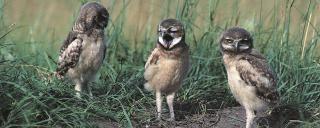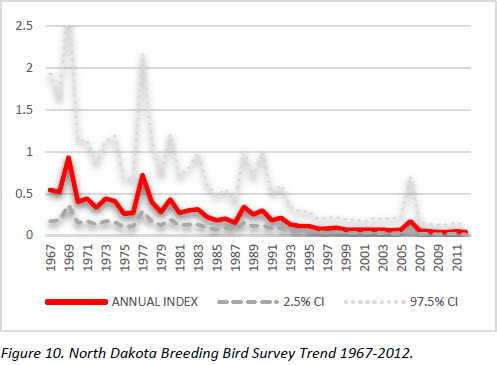
Burrowing Owl
| Scientific Name | Athene cunicularia |
|---|---|
| General Description | L 9.5”, WS 21”, 5 oz. A small owl with long legs, a spotted dark brown and buffy breast, white throat, and large yellow eyes. |
| Status | Occurs in North Dakota from April to September. Peak breeding season early May to mid-August. |
| Abundance | Uncommon. |
| Primary Habitat | Shortgrass or grazed mixed-grass prairie with burrows dug by mammals present. |
| Federal Status | Migratory Bird. |
| Reason for Designation | Burrowing Owls once occurred nearly statewide. Currently are found primarily south and west of the Missouri River because of declines in burrowing mammal populations east of the Missouri River. It is included on the USFWS Bird of Conservation Concern list in Region 6 BCR and 17. Partners in Flight (PIF) identifies the Burrowing Owl as a Regional Concern Species. |
Locations and Conditions of Key Habitat
Preferred Habitat
Burrowing Owls are found in open grasslands of sparse, short vegetation (less than 10 cm) and bare ground such as in moderately or heavily grazed pasture. Native prairie, tame pasture, hayland, fallow fields, road and railway rights-of-way are used. Rely exclusively on burrowing mammals to create burrows for nest sites. Most often use abandoned black-tailed prairie dog and Richardson’s ground squirrel burrows. Sometimes concentrate nests at the edge of colonies, presumably because of increased perch availability, high insect populations, and close proximity to foraging areas. Also may use badger, woodchuck, skunk, fox, and coyote burrows. Feed primarily on arthropods and small mammals such as voles.
Key Areas and Conditions for Burrowing Owl in North Dakota
No specific sites have been identified. Black-tailed prairie dog towns are key areas, which are concentrated in two populations; Sioux, southern Grant, and southern Morton counties (i.e. Standing Rock Reservation area), and the Little Missouri National Grasslands.
Problems Which May Affect this Species
Habitat
Destruction and/or degradation of native prairie. Removal of prairie dogs from colonies causes a deterioration of burrows and denser, taller vegetation. Burrowing Owls may discontinue use of abandoned towns due to the unsuitable habitat. Habitat fragmentation may also allow predators to more easily find nests and mortality is highest during the post fledgling period.
Other Natural or Manmade Factors
Burrowing Owls use shredded horse or cow manure to line nests. If this is not available, nest success has shown to be lower due to depredation of nests. The number of nonresidents coming to North Dakota to shoot prairie dogs is increasing, however, there is no data to suggest shooting has a significant impact on prairie dog populations or that a substantial number of Burrowing Owls are mistakenly or even deliberately being shot. The effects of pesticide use on prairie dog towns and the subsequent effect on owls is unclear, but believed to have negative impacts.
Research and Survey Efforts
Current Research or Surveys
- Nothing specific to the species in North Dakota.
Previous Research or Surveys
- Northern Prairie Wildlife Research Center (ND SWG T-3-1) surveyed the distribution of Richardson’s ground squirrel colonies and use by Burrowing Owls in North Dakota. The project was initiated in 2003 and a final report provided in 2005. Burrowing Owls were found in only 2 (1.7%) of townships surveyed (Sovada et al. 2005).
- Nest site selection, productivity, survival and movements of Burrowing Owls have been examined on the Little Missouri National Grasslands (Restani 2001, Davis and Restani 2006).
- From 1994-99, Burrowing Owls were searched for intensively and incidental sightings were collected. Results indicate the Burrowing Owl range in North Dakota is contracting to south and west of the Missouri River.
- A few reports on the food habitats or nesting ecology have been conducted in North Dakota.
- Numerous published reports and gray literature on this species throughout its range.
Additional Research or Surveys Needed
- Identify traditional and consistent nesting sites.
- Determine the effects of contaminants or insecticides on prey species.
- Further explore landscape features affecting nest site selection.
Population and Trend Estimates

- PIF Global Population Estimate: 2,000,000
- PIF North American Population Estimate: 700,000
- PIF North Dakota Population Estimate: 5,000
- North Dakota BBS Trend: see figure 10
- Survey-wide BBS Trend 1966-2012: -1.11
Management Recommendations
- Preserve traditional nesting sites.
- Maintain large, contiguous areas of native grassland and treeless plains.
- Provide a mosaic of tall grass for foraging, short grass for nesting and roosting.
- Artificial nest structures may be used where burrows are scarce.
- Allow moderate to intense grazing in areas that support tall vegetation.
- Choose insecticides with the lowest toxicity to non-target organisms.
- If necessary, restrict the timing of lethal control of burrowing mammals to avoid the period when Burrowing Owls are nesting.
- Maintain abandoned prairie dog colonies at short vegetation less than 8 cm with mowing or grazing.
- Implement rotational grazing to increase prey populations.
Monitoring Plans
According to the Partners in Flight Landbird Conservation Plan, long-term population trend monitoring such as the Breeding Bird Survey is generally considered adequate, but may not account for some issues (e.g. bias). However, few BBS routes intersect with Burrowing Owl habitat. The NDGF will continue to maintain a list of known Burrowing Owl nest sites.
2005-2015 Progress
The Burrowing Owl remains a Level II Species of Conservation Priority. A nest site spatial database has been developed and is being used to minimize impacts to nesting owls.

Note: A listing of works consulted when compiling the information on this page may be found in the 2015 State Wildlife Action Plan.
